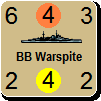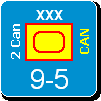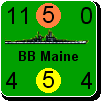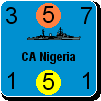warspite1
Posts: 41353
Joined: 2/2/2008
From: England
Status: offline

|
Please see an example of the US ASW units - the sad story of the USS Edsall...
[4214 ASW Escort - by Robert Jenkins]
.P These ASW counters are only used if playing with the Convoy In Flames optional
rule. The counters do not represent any specific individual convoy or any
particular ships, but are designed to represent convoy escort groups. They have
mixed values reflecting the fact that the make-up of an escort group could differ
from one convoy to the next. Examples of the main ship types that were used in
the convoy escort role during the Second World War are: escort carriers,
destroyers, destroyer escorts, corvettes, sloops and trawlers. As can be seen, a
wide variety of ship type was used in the defence of convoys.
.P In the years following the end of the First World War, the United States Navy
(USN) neglected the subject of trade protection. As a continental power, the need
for defending merchant shipping was perhaps not seen as being as important as the
ability to field a strong surface fleet; after all, it was argued, such a fleet
would sweep the oceans clear of any enemy shipping.
.P As a result of this thinking, at the time that the United States was thrust
into World War II, courtesy of the Japanese attack on Pearl Harbor and Hitler's
subsequent declaration of war in December 1941, the USN was unprepared for large
scale trade protection operations.
.P This shortcoming was still in evidence despite the fact that elements of the
USN had been employed on convoy defence duty since the start of the war in
Europe. On the 4th September 1939 President Roosevelt ordered the setting up of a
"Neutrality Patrol", under which USN ships were initially tasked with tracking
and reporting the movements of belligerent naval vessels in the Atlantic Ocean.
As time went on however, and with the USA still neutral, USN ships took part in
convoy escort operations as far eastward as Iceland.
.P The escorts were ostensibly to protect American shipping, but in actual fact,
stretched US neutrality to the limit, and indeed led to the loss of the destroyer
Reuben James to a German U-boat in October 1941.
.P Fortunately for the Americans, when war came in the Pacific, the Japanese were
not in any position to take advantage of the USN's unpreparedness. The IJN
submarine service proved a largely impotent force, and in any case, the Japanese
high command simply did not appreciate the value of attacking the Allied shipping
that took troops and supplies from the US to Australia and numerous Pacific
islands; strongpoints from which the Americans and their Allies would launch
their comeback against the Japanese.
.P Sadly, in the North Atlantic, the USN were punished more severely. German
U-boats inflicted many months of pain on Allied merchant shipping sailing along
the US East Coast before the USN got on top of the situation.
.P During this second "Happy Time" for the German U-boat crews, they were able to
take advantage of the US decision not to mount convoys in those waters. However,
a combination of US industrial strength and capable administrators and naval
personnel, meant that before long the Germans were on the back foot once more.
.P During 1942/43, wave after wave of escort carriers, destroyer escorts and
patrol frigates were built in US shipyards. Merchant shipping not only benefited
from an ever increasing number of escort vessels, but also from the increased
effectiveness of those escorts, as better anti-aircraft (AA) and anti-submarine
(ASW) capability was developed.
.P Convoy protection work was extremely tough, hazardous work but had none of the
glamour that was associated with the carriers and battleships of the fleet. But
the work was vital, and thanks to the bravery and sacrifice of those sailors and
airmen that undertook these operations, thousands of essential troop and supply
movements were completed, enabling the Allies to take the war to the enemy on
both sides of the world.
.P Note, the date on the back of these ASW and ASW Carrier counters do not relate
in any meaningful way to actual build dates for the ships that took undertook the
convoy escort role during World War II. The counter date should therefore be
ignored. These ASW counters are also used to tell some of the more important, non
-convoy related, episodes of the war that involved these smaller vessels.
.P This write-up looks at the Clemson-class destroyers, and in particular, the
USS Edsall.
.B
.B Name: USS Edsall
.B Engine(s) Output: 27,000 hp
.B Top Speed: 35 knots
.B Main Armament: 4 x 4-inch (102mm), 1 x 3-inch (76.2mm) guns
.B Displacement (full load): 1,308 tons
.B Thickest Armour: N/a
.P The Clemson-class destroyers were built for the USN between 1918 and 1921.
They were originally to have numbered one hundred and sixty-one ships, although
the last five vessels were cancelled. Their construction followed hot on the
heels of the six-ship Caldwell-class and the one hundred and eleven ship Wickes-
class; together, these ships were generally known as the "Flush Deck-Class".
.P For their main armament the Clemsons were given four single 4-inch guns,
although the capability to fit a larger 5-inch weapon was included in the design.
In actual fact, only five Clemsons received the bigger gun, while another two had
four twin 4-inch guns installed. Secondary armament was originally limited to a
single 3-inch gun, but those ships that survived to see service in World War II
benefited from increased AA protection. Their weapons package was completed by
four, triple 21-inch torpedo tubes.
.P One of the key design requirements was for a top speed of 35 knots. This was
necessary in order for the destroyers to keep pace with the planned Lexington-
class battlecruisers and the Omaha-class scout cruisers.
.P Another key objective in the Clemsons design was the need to increase range;
one of the weaknesses in the Wickes-class. A 35% increase in fuel was achieved in
the latter ships.
.P The number of Flush Deckers in service with the USN during the Second World
War was reduced due to a variety of reasons including peace time accidents,
sales, scrapping (largely due to the terms of the 1930 London Naval Treaty) and
transfers to the Royal Navy. By December 1941 the Clemsons numbered less than
seventy ships, of which only thirty-nine were still operating as destroyers.
.P The ships of the class were named after former USN sailors, with Edsall being
named in honour of Norman Eckley Edsall, who fought during the Spanish-American
war.
.P USS Edsall was completed in November 1920. Her early years were spent on duty
in the Mediterranean, before she was transferred to the Asiatic Fleet in 1925.
It was with this command that she was deployed at the time of the Japanese strike
on Pearl Harbor in December 1941. She and three other destroyers; Alden, John D
Edwards and Whipple formed the 57th Destroyer Division (DesDiv) based at
Balikpapan, Borneo.
.P The commander of the Asiatic Fleet, Admiral Hart agreed to send DesDiv 57 to
Singapore to bolster the Royal Navy's Force Z. Unfortunately, by the time the USN
destroyers reached Singapore, Force Z's two capital ships, Prince of Wales and
Repulse had both been sunk in an air attack off Kuantan.
.P The US ships were ordered to sea to search for survivors, and while
undertaking this operation, Edsall intercepted the Japanese fishing trawler,
Shofu Fu Maru, which she escorted back to Singapore.
.P Edsall was ordered to sail for Soerbaya, Java a few days later in order to
join up with the heavy cruiser USS Houston. From there Edsall was tasked with
escorting shipping from the Dutch East Indies to the northern Australian port of
Darwin. This work continued until the first week of February 1942. On the 20th
January, Edsall, in conjunction with three Royal Australian Navy minesweepers,
sank the Japanese submarine I-124.
.P In early February Edsall was transferred back to Java, this time to the port
of Tjilatjap from where she conducted ASW operations alongside the gunboat USS
Asheville. Edsall's top speed was reduced following damage received when one of
her own depth charges exploded too close to her stern. For now, this reduced
performance was not too much of an issue, but would play a part in her ultimate
demise.
.P At the end of that month Edsall and Whipple sailed from Tjilatjap in order to
escort the seaplane tender USS Langley on the last part of her journey. Langley
was carrying vital aircraft reinforcements to the Dutch East Indies. But on the
27th, the three American ships were found by Japanese aircraft and came under
heavy attack. Langley was seriously damaged and had to be scuttled as a result.
Edsall picked up 177 men, a mixture of Langley's crew and the airmen she was
transporting (See USS Langley). Although Edsall survived this encounter, her end
was to be not long delayed.
.P Edsall and Whipple were refuelled at sea by the tanker USS Pecos off Christmas
Island in the Indian Ocean. There they transferred the survivors from Langley to
the auxiliary. On the 1st March Pecos then sailed for Java, while Whipple was
ordered to the Cocos Islands to rendezvous with another tanker. Sadly, Pecos was
found and sunk by Japanese aircraft before reaching her destination.
.P Meanwhile, Edsall, which was reacting to the distress signals sent from Pecos,
was also in trouble. Vice-Admiral Nagumo, with elements of his First Air Fleet,
were operating south of Java at this time in order to prevent fleeing Allied
shipping reaching Australia. It was Nagumo's aircraft that had sunk Pecos, and at
about 1600hrs, the heavy cruisers Tone and Chikuma spotted Edsall less than
twenty miles from the Japanese task force.
.P What was to follow was an amazing running battle between Lieutenant Nix's
plucky little destroyer and Nagumo's vaunted Kido Butai; it was an encounter that
could only end one way.
.P Nagumo did not order his aircraft aloft to deal with Edsall. Instead, the US
ship was to be blown out of the water by the 8-inch shells of the two heavy
cruisers - except this did not happen. After about fifteen minutes of inaccurate
fire from Chikuma and Tone, Nagumo ordered his battleships, Hiei and Kirishima to
open fire with their 14-inch main guns. Aboard Edsall, Nix knew that he could not
outrun the enemy ships and ordered smoke as he sought to keep the distance; so
limiting his tormentors to long range fire.
.P Nix skillfully altered his speed and direction in a bid to avoid the enemy
shells, but he must have known that he could not avoid the inevitable. At one point
Nix ordered his ship to close the range in order to threaten a torpedo strike and
allow him to bring his own 4-inch guns into the battle. However, these attempts
came to nothing. Nagumo must have felt extreme frustration, and not a little
embarrassment that his ships could not sink Edsall.
.P In total, around 1,400 shells were fired by the four Japanese warships, but
only two shells found their target. Nagumo felt he had little choice but to
launch an air strike. Dive-bombers from two carriers were ordered in the air and
at 1731hrs - an hour and a half after Edsall was first spotted - she disappeared
beneath the waves having been pounded into submission by numerous bombs.
.P Due to the Japanese fearing the presence of an Allied submarine, only a few
survivors were picked up but none were to see their homes again. After the war,
34 decapitated bodies were found in a grave in the East Indies, half a dozen of which
were identified as being sailors from Edsall.
< Message edited by warspite1 -- 5/15/2011 2:03:03 PM >
_____________________________
England expects that every man will do his duty. Horatio Nelson October 1805  |
 Printable Version
Printable Version



















 New Messages
New Messages No New Messages
No New Messages Hot Topic w/ New Messages
Hot Topic w/ New Messages Hot Topic w/o New Messages
Hot Topic w/o New Messages Locked w/ New Messages
Locked w/ New Messages Locked w/o New Messages
Locked w/o New Messages Post New Thread
Post New Thread